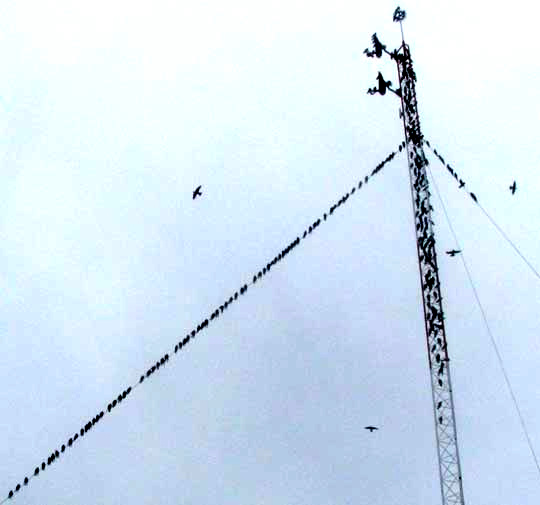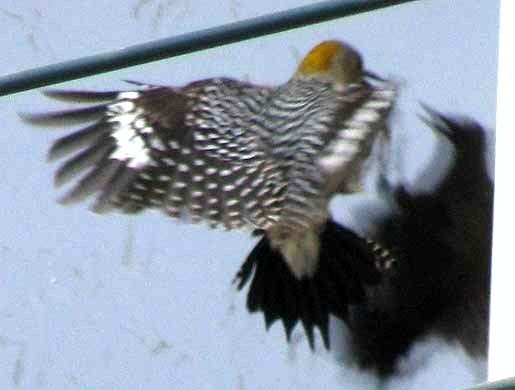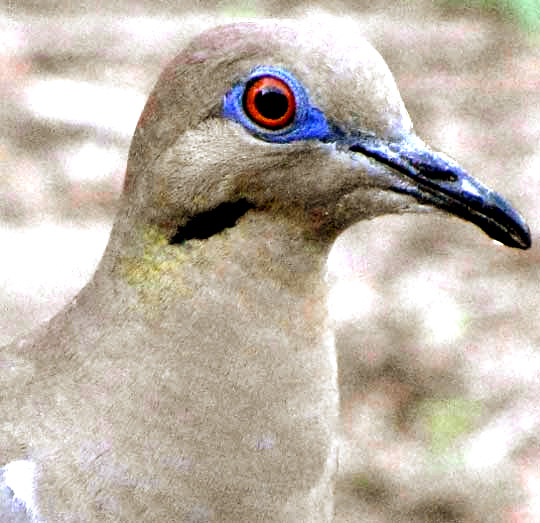 Even ordinary backyard birds do extraordinary things. Purple Martins, for instance, who frequently nest in backyard bird boxes throughout most of North America, spend their "winters" in Brazil, in South America, where it's summer on the other side of the Equator. In the picture, a flock is shown resting on the Yucatan Peninsula's Caribbean coast in August, during their flight southward. That Purple Martins should fly such a great distance and then find their ways back to where they began -- often the same nesting site as the year before -- is simply amazing. One wants to believe that Purple Martins must possess at least a glimmer of genius with regard to navigating and flying such long distances.
Even ordinary backyard birds do extraordinary things. Purple Martins, for instance, who frequently nest in backyard bird boxes throughout most of North America, spend their "winters" in Brazil, in South America, where it's summer on the other side of the Equator. In the picture, a flock is shown resting on the Yucatan Peninsula's Caribbean coast in August, during their flight southward. That Purple Martins should fly such a great distance and then find their ways back to where they began -- often the same nesting site as the year before -- is simply amazing. One wants to believe that Purple Martins must possess at least a glimmer of genius with regard to navigating and flying such long distances.

On the other hand, it's also true that if, soon after hatching, baby ducklings see a cardboard box pulled by a string passing by, they'll follow the box as if it were their mother. Moreover, as the ducklings grow up, they'll continue to follow the box. They just do not catch on... Hearing this, birds seem pretty dumb.
AFRICAN GRAY PARROT
On September 6, 2007, Alex the African Grey Parrot died at age 31. At Brandeis Univerisity scientist Irene Pepperberg had studied Alex for years. She documented Alex learning enough English to identify 50 different objects, 7 colors, 5 shapes, quantities up to and including 6, and a zero-like concept. He used phrases such as "I want X" and "Wanna go Y", where X and Y were objects and place-names. He developed concepts of categories, bigger and smaller, same-different, and absence. He combined words to identify, request, refuse, and categorize more than 100 different items.
Smart... Dumb... Just how smart are birds?
The correct answer is that birds, whether they're flying to Brazil or following a cardboard box, are beautifully adapted for their bird lives, and they have exactly appropriate brains and behaviors needed for the way they live.
We shouldn't ask how smart birds are, but we can indeed wonder how bird intelligence works. It isn't always as obvious as it seems. For instance, consider the situation with pigeons:
Young pigeons begin flapping their wings and flying erratically at a certain age, and their flying ability improves with time. This "learning process" strikes us humans as natural and inevitable because human babies go through "practice stages" learning to walk and talk.
However, in a classic experiment done during the 1930's, a German ethologist -- a biologist studying animal behavior -- by the name of J. Grohmann reared a group of pigeons in tubes, so that they could never flap their wings. Another group of pigeons of the same age was allowed to develop in the open, going through weeks of wing-flapping and fluttering. When the pigeons in the open finally became able to fly, the pigeons in tubes, who'd never even spread their wings, were released. Amazingly, the tube-pigeons also could fly.
Therefore, what appears in nature to be "young pigeons learning to fly" is clearly something else, for young pigeons don't have to learn how to fly. They are born with that knowledge; their flying ability is innate.
When we make the error of assuming that other animals behave the way they do for reasons that "make sense" from the human perspective, we're guilty of anthropomorphism. We're being anthropomorphic when we assume that adult birds feed their nestlings because they love them, or that male birds chase other male birds from their mates because they're jealous. "Love" and "jealousy" are human emotions, not bird.
This leads to some interesting questions. Could it be that birds do feel love and jealousy, just feel it differently than humans? And, isn't it true that even humans feel love in different ways at different times and in different contexts?

You may be surprised to learn that these simple-sounding questions still can't be answered to everyone's satisfaction. Some serious scientists would say that birds feel a lot, though not what we humans feel. Others would say that birds are almost like mindless little machines, and others hold in-between positions. The female Golden-fronted Woodpecker at the right... Is she angry at the intruder in her nesting territory? Or is she reacting reflexively to a woodpecker image while feeling and thinking absolutely nothing? Something in-between? Something no human can imagine?
As more and more results from research on the matter are published, gradually the consensus is shifting away from the "mindless little machines" position, toward "something that humans may be able to imagine." A 2020 article by Bret Stetka in Scientific American was entitled, "Bird Brains Are Far More Humanlike Than Once Thought".

That paper mentions pigeons trained to distinguish between the paintings of Picasso and Monet, and ravens who recognize themselves in mirrors. New discoveries suggesting the bases of these bird capabilities include that bird brains possess a newly recognized structure comparable to the mammalian neocortex, which allows for complex cognition and creativity. Among crows, ravens and magpies, this region of the brain has "about as many neurons as you'd find in primates with a much larger brain."
And, of course, we humans are primates with much larger brains.